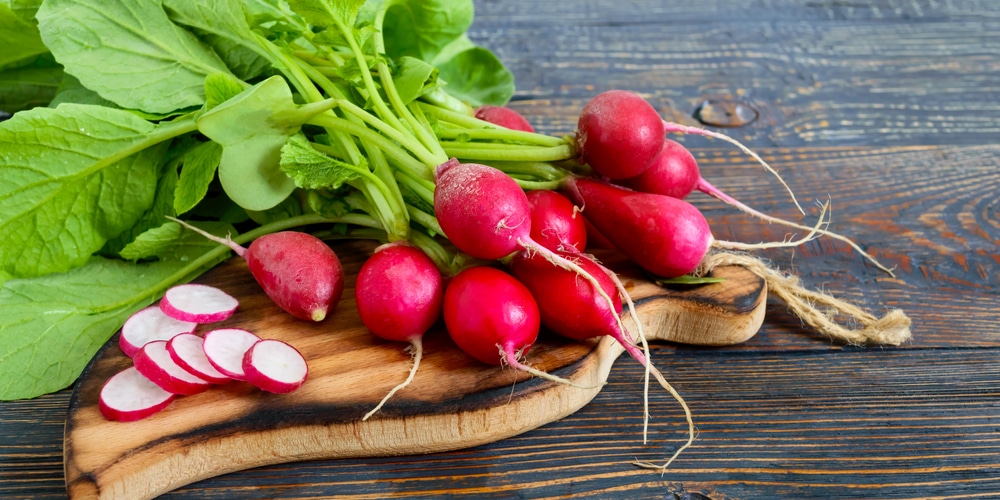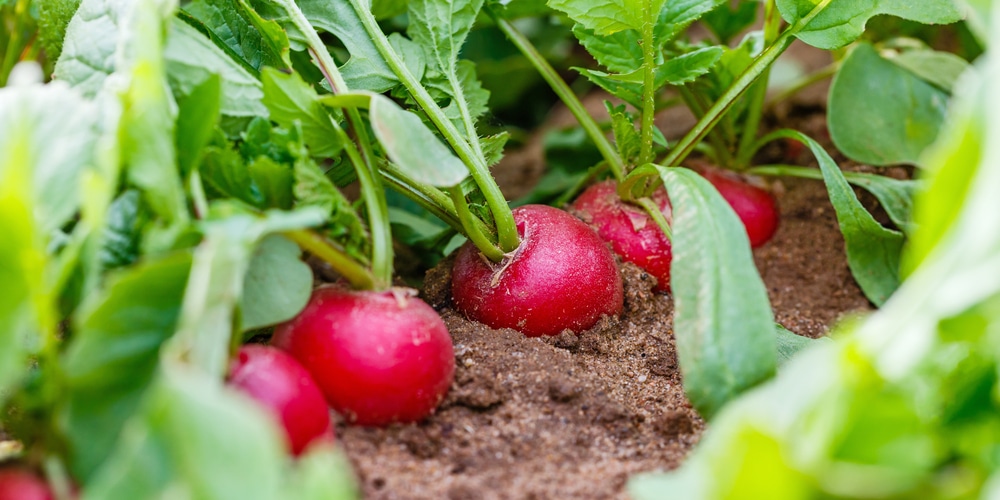Radishes are very versatile vegetables that are easy to plant and grow. There are, nonetheless, several tips that you should follow if you want to have a bountiful radish harvest.
In this article, we’ll disclose some important details about radishes, including their growing season, the best soil conditions for them, their watering demands, and storage methods. We’ll also look at when to plant radishes in zone 7.
What are Radishes?

Radishes are root vegetables that sport a wide variety of skin colors (ranging from white to red, pink, yellow, purple, or even black). Their flesh, however, is normally white.
These members of the cabbage family grow mostly in temperate climates such as those found across Europe, North America, and “Temperate Asia” (which includes the Japanese islands, Mongolia, a great portion of China, the entire Korean Peninsula, etc.)
Radishes are grown for their roots or bulbs, which are the edible parts of the crop. They make for great garden salsas or cool salads. Since radishes have a pungent flavor, they’re likewise excellent for accompanying salty dishes.
There is a broad array of radish variants to choose from. If you’re not too fond of the strong flavor of the traditional Raphanus sativus, you could try to plant some from the Brassica family, which may deliver sweeter or milder flavors.
Their nutritional value is also something worth pondering about. Radishes are immensely rich in antioxidants and minerals such as calcium and potassium. All of these properties make them perfect for lowering high blood pressure and combating cancer.
When to plant radishes in zone 7
They are considered “cool weather” vegetables, so intense summer heat should be avoided at all costs.
Plant hardiness zones 2 through 10 are the best zones for growing radishes. So, for example, If you’re wondering when to plant radishes in zone 7 (in-between 2 and 10), the most ideal period would be in the early spring or very late summer.
According to the season, radishes are classified as “spring radishes” and “winter radishes”. Examples of spring radishes include the “Cherry Bomb” and “Crimson Giant”. The “China Rose”, which is ordinarily deemed as a “winter radish”, should be planted in early fall since they take a bit longer to mature than most others.
The average radish can be harvested after 3 weeks of planting.
How to Store Them?
During the summer months, radishes can be kept in the fridge for a period of one week. Simply cut off the greens and root ends, store them in a tightly sealed jar with water, and place the jar behind the fridge doors.
If you plan on keeping a large batch for longer periods (at least longer than a week), you may store them in the freezer, but not before blanching them.
Blanching deactivates the enzymes responsible for the loss of flavor and aroma in several greens and crops. After blanching, you may stow the unpeeled radishes in airtight Ziploc bags or containers and push them into your freezer cabinet.
Tips for Growing Radishes
Before planting your radishes, it’s crucial that you take note of the following:
Regarding soil conditions:
The soil used for the plants should be rich in organic matter and not compacted, so as to allow for proper drainage. If your soil is clay-like, you may want to mix it with some compost, which will improve drainage and fertility.
If you’re going to use manure, make sure it’s well-rotten but not fresh, for it may prompt the appearance of weeds and hurtful bacteria.
You should measure the acidity of the soil as well. The soil should be loose but also relatively acidic, with a pH ranging between roughly 6.0 and 7.0.
You should remove any hard formations, such as rocks and dirt clods, by tilling the soil before proceeding to plant the radish seeds.
Regarding the seeds and roots:
While radish seeds tend to have an enduring shell life, they should be planted before they reach 5 years of age. As time passes, some seeds will eventually lose their germinating capabilities.
Roots should not be disturbed with constant transplanting. It’s best to directly sow the radish seeds in your garden. The spot where you’ll plant the radishes should receive at least 6 hours of sunlight per day, especially in the morning.
Regarding irrigation:
Radishes need to be watered constantly, but evenly. Waterlogging the soil will produce splits and cracks in the roots, while severely dry soils will render tough roots. Irrigation must be constant yet moderate.
When to plant radishes in zone 7: Conclusion
Radishes are definitely a great addition to your garden. Not only do they enhance the landscaping in your garden area, but they’re also a great food supply during the coldest months of the year.
Hopefully, we’ve been able to walk you through the most important aspects to look after when planting, growing, and harvesting radishes in this short gardening guide.
Related Article: When to Plant Radishes in Iowa?

